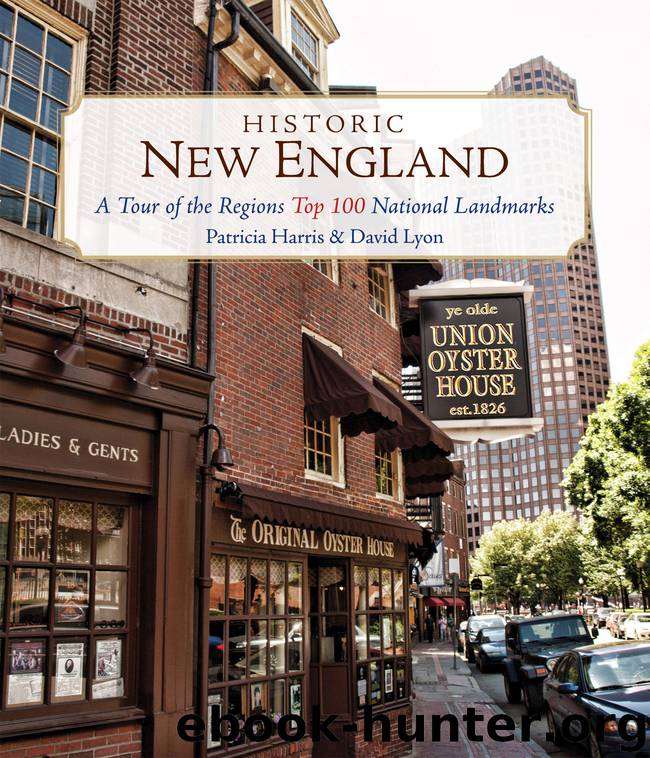Historic New England by Patricia Harris & David Lyon

Author:Patricia Harris & David Lyon
Language: eng
Format: epub
ISBN: 9781493024551
Publisher: Globe Pequot Press
Longfellow House, Cambridge
105 Brattle Street, Cambridge; 617-876-4491; nps.gov/long; open for guided tours late-May through October; admission charged
Given his patriotism and his fascination with American myth and history, it must have given Henry Wadsworth Longfellow (1807–82) considerable pleasure to know that George Washington had, indeed, slept in his house—even if it was decades earlier. The large Georgian manse known as the Longfellow House was constructed in 1759 for merchant John Vassall. Many of the Massachusetts Bay Colony’s wealthiest merchants chose to live in Cambridge to enjoy the amenities of life in a college town. And many of them, like Vassall, were loyal subjects of the king. Like the others, Vassall built on “Tory Row,” the stretch of Brattle Street that begins just behind Christ Church and extends about a mile out of Harvard Square. Surrounded by long, green lawns and Georgian gardens, these blocky mansions sit in removed majesty as models of proportion and order. As anti-crown tensions rose in the mid-1770s, most of their owners fled. The state auctioned off their homes after the Revolution.
When George Washington came to Cambridge in July 1775 to assume command of the Continental Army and continue to lay siege to the British who held Boston, he chose the vacant Vassall house as his headquarters. He would stay for nine months, welcoming Martha to their first wartime home, receiving diplomats, and plotting strategy. He left the house in April 1776 after the British withdrew all their forces from Boston on St. Patrick’s Day.
The house was sold in 1791 to Andrew and Elizabeth Craigie, who enlarged and redecorated what was soon known as “Craigie Castle.” It could have been called “Craigie’s Folly,” as the expansion plunged the couple into debt. When Andrew died, Elizabeth was forced to take in boarders to make ends meet. One of them was a young Harvard professor of modern languages, Henry Wadsworth Longfellow, who began renting two rooms in 1837, shortly after his return from Europe, where his first wife, Mary, had died of complications from a miscarriage.
On his grand tour before assuming his professorship, Longfellow had met Frances “Fanny” Appleton in Switzerland. Her father was one of the three founders of the Merrimack Manufacturing Company, which developed the mill system in Lowell and pioneered the American textile industry. Appleton was initially skeptical of a poet-scholar wooing his daughter, but the young widower was persistent, often walking from Cambridge to Beacon Hill to call on her. When they finally wed in 1843, her father presented them with Craigie Castle as a wedding gift. It remained in the Longfellow family until the Longfellow House Trust donated it to the National Park Service in 1972.
Download
This site does not store any files on its server. We only index and link to content provided by other sites. Please contact the content providers to delete copyright contents if any and email us, we'll remove relevant links or contents immediately.
Giovanni's Room by James Baldwin(6820)
The Plant Paradox by Dr. Steven R. Gundry M.D(2436)
The Stranger in the Woods by Michael Finkel(2331)
Miami by Joan Didion(2167)
Wild: From Lost to Found on the Pacific Crest Trail by Cheryl Strayed(2145)
INTO THE WILD by Jon Krakauer(2089)
Trail Magic by Trevelyan Quest Edwards & Hazel Edwards(2064)
DK Eyewitness Top 10 Travel Guides Orlando by DK(2060)
Vacationland by John Hodgman(2034)
The Twilight Saga Collection by Stephenie Meyer(2029)
Nomadland by Jessica Bruder(1960)
Birds of the Pacific Northwest by Shewey John; Blount Tim;(1876)
The Last Flight by Julie Clark(1844)
Portland: Including the Coast, Mounts Hood and St. Helens, and the Santiam River by Paul Gerald(1822)
On Trails by Robert Moor(1795)
Deep South by Paul Theroux(1718)
Blue Highways by William Least Heat-Moon(1665)
Trees and Shrubs of the Pacific Northwest by Mark Turner(1646)
1,000 Places to See in the United States and Canada Before You Die (1,000 Places to See in the United States & Canada Before You) by Patricia Schultz(1558)
